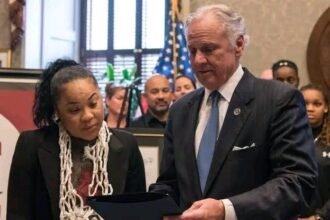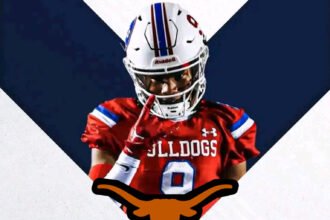The Ohio State Buckeyes football program is currently navigating a tumultuous period marked by allegations of tampering involving star wide receiver Jeremiah Smith. Reports have surfaced indicating that other collegiate programs have extended substantial Name, Image, and Likeness (NIL) offers to Smith, aiming to entice him into the transfer portal. These developments have cast uncertainty over Smith’s future with the Buckeyes and have ignited broader discussions about the integrity of recruitment practices in college football.
Jeremiah Smith, a freshman sensation from Hollywood, Florida, has been instrumental in Ohio State’s recent successes. His remarkable performances on the field have not only shattered records but have also positioned him as a pivotal figure within the team. However, his rising prominence has attracted attention beyond the confines of Columbus. According to reports, Smith has received offers exceeding $4.5 million in NIL deals from rival programs, aiming to lure him away from Ohio State.
Ohio State head coach Ryan Day has addressed these allegations with a call for stricter enforcement of recruitment regulations. In an appearance on “The Dan Patrick Show,” Day emphasized the challenges posed by the current landscape, stating, “One of the big issues we have across the board in college football right now is enforcement… Until we start enforcing some of these rules, people can just call someone’s agent or someone’s parents and offer them a certain amount of money, and then it goes from there.”
Despite the swirling rumors, Smith has publicly reaffirmed his commitment to Ohio State. Responding to a fan’s post on social media denying the transfer speculation, Smith concurred, effectively quelling some of the concerns regarding his potential departure.
The situation has sparked a broader conversation about the evolving dynamics of college athletics, particularly concerning NIL agreements and the transfer portal. The ability of external programs to offer lucrative deals to student-athletes from rival schools raises ethical questions and challenges the existing framework designed to maintain fair competition and protect the interests of student-athletes.
In addition to the tampering allegations, the Ohio State football program is contending with other internal challenges. Reports indicate that an assistant defensive coach has been placed on administrative leave pending an investigation into unspecified matters. While details remain scarce, this development adds another layer of complexity to the current state of affairs within the Buckeyes’ camp.
Furthermore, the program has been subjected to external critiques from rival factions. Former Michigan staffer Connor Stalions, previously implicated in a sign-stealing controversy, has directed disparaging remarks toward Ohio State and Jeremiah Smith. Such exchanges underscore the intense rivalries and the often contentious atmosphere that pervades collegiate football.
Amid these challenges, the Ohio State administration and coaching staff are focused on reinforcing the program’s values and ensuring compliance with NCAA regulations. The emphasis remains on fostering an environment where student-athletes can thrive academically and athletically, free from undue external influences.
The unfolding situation with Jeremiah Smith serves as a microcosm of the broader shifts occurring in college sports. The advent of NIL agreements has introduced new opportunities and complexities, necessitating a reevaluation of policies to safeguard the integrity of collegiate athletics. As programs navigate this evolving landscape, the balance between embracing innovation and maintaining ethical standards remains a delicate endeavor.
In conclusion, the Ohio State Buckeyes are at a critical juncture, contending with external pressures and internal challenges that have cast a shadow over the program’s recent achievements. The allegations surrounding Jeremiah Smith highlight the pressing need for clear guidelines and robust enforcement mechanisms in the era of NIL and the transfer portal. As the situation develops, the responses from the NCAA, collegiate programs, and student-athletes will undoubtedly shape the future contours of college football





